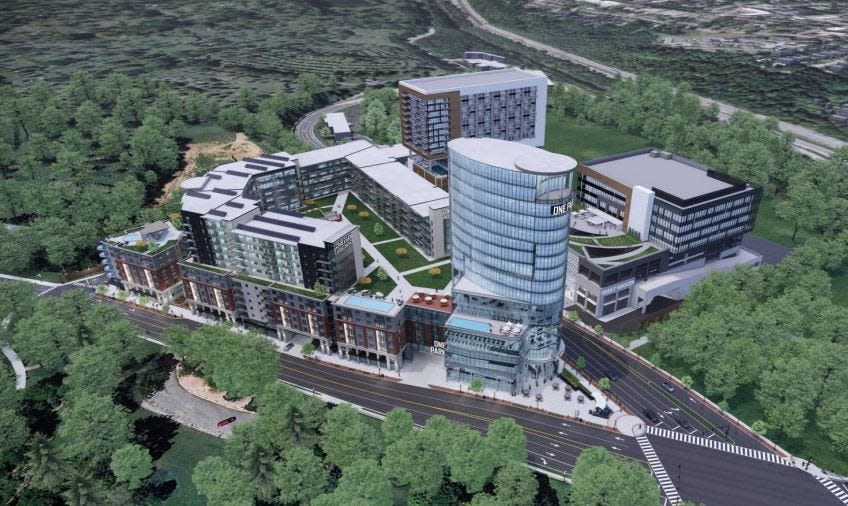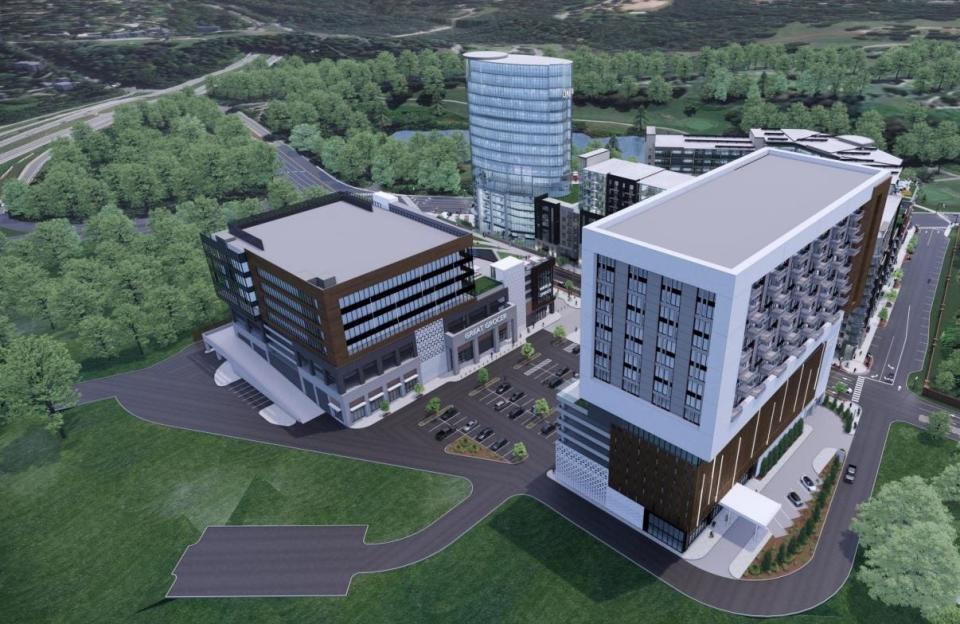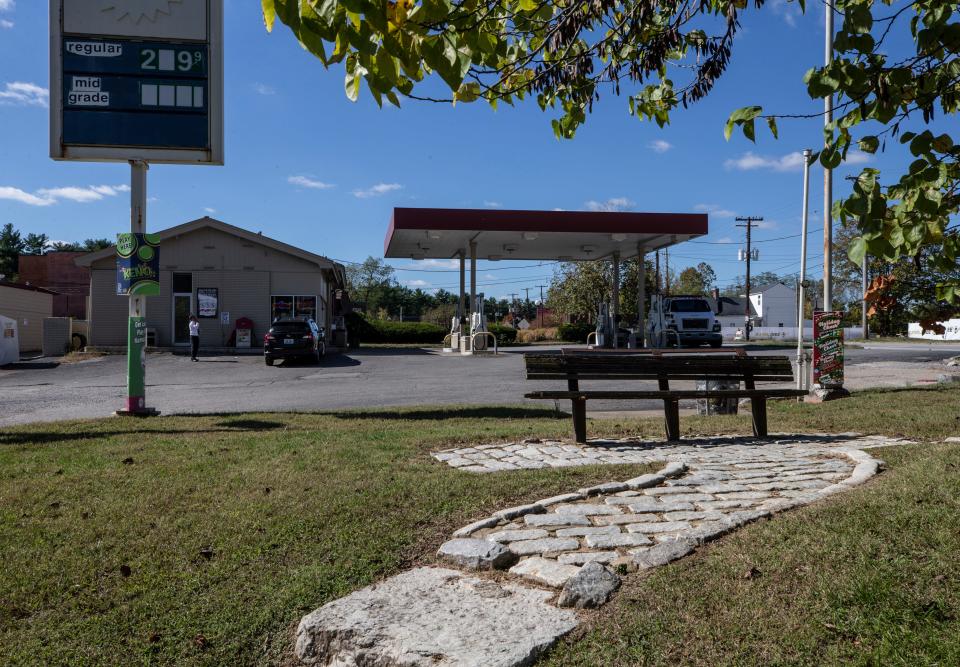The $114 million question: How much Louisville tax money should One Park developers keep?

After years of debates, the plan for the colossal One Park plaza — which would reshape a busy Louisville block with towers filled with retail spaces, restaurants, offices, apartments and other amenities — has the green light.
But the question of how to fund the over $500 million project remains.
Now, the city is moving to support the developer behind the plaza, Louisville-based Jefferson Development Group, with a tax-increment financing plan that would divert a majority of tax revenue it raises back to the property owner.
Metro Council President Markus Winkler, who sponsored the ordinance, said One Park is unlike anything in Louisville, describing it as a "transformative project for the city" that would attract businesses looking to relocate, as well as the young professionals they'd seek to hire. It's worth the price, he believes, for the future of the local economy.
"Having something like this available in the market is very, very beneficial as site selectors are searching," Winkler said.
Still, not everyone is convinced the eye-catching development is worth the cost to taxpayers. Louisville resident Diane Bellafronto, a common sight in recent years at several public meetings held during the planning process, said the public is "being sold a line" that the complex would attract new crowds and businesses.
"People don’t move because of a building or because of a development," she said. "They move for jobs, they move for education, they move for quality of life, but they don’t move for a development building. That’s the way this is being sold, and now they want to finance it with tax money that really should be going to other priorities in the city.”
The ordinance was introduced at Thursday's Metro Council meeting. It was assigned to the Labor and Economic Development Committee, where it'll be discussed next week before eventually coming back before the full chamber. A public hearing is also scheduled for Monday evening.
It's a plan that's drawn some criticism. But Louisville Cabinet of Economic Development Executive Director Jeff O'Brien said government investment is common in projects of this magnitude — and as construction costs have risen in recent years, providing some support to the developer to build a "signature project for the state" is worth the money.
"This particular project, and many like it, would likely need some form of city subsidy just in terms of the redevelopment costs," he said Friday morning. "... All urban redevelopment projects, whether they are at the nexus of the Highlands neighborhoods and the Crescent Hill neighborhood or whether they're in downtown or whether they're in any other urban neighborhood, there are higher costs."
The One Park plaza
The One Park plan would reimagine a well-traveled Irish Hill block between Grinstead Drive, Lexington Road and Etley Avenue that connects the area to Crescent Hill and the Highlands.
With an expected price tag of about $554 million (including about $165 million in public infrastructure improvements), that seven-acre plot would be transformed with an 18-story multi-use tower at the center of the project and an additional 10-story tower across the street where Jim Porter's Good Times Emporium once stood.
The complex would include about 240,000 square feet of office space, 60,000 square feet for retail and restaurants, 50,000 square feet for a grocery store, a 200-room hotel, 600 to 700 apartment units, along with two parking garages and additional amenities.
A small portion of residential units would qualify as affordable housing — a requirement that 7% of those apartments would be rented at rates below the city's median income is in the ordinance, though the developer could cut that to 5% with a payment of about $1 million to Louisville’s Affordable Housing Trust Fund.
Jefferson Development Group previously committed in September 2019 to set 10% of units as affordable housing if a TIF were included in the project, a number in line with goals listed on the city's economic development website. It's a higher figure than what was included in the new ordinance, but O'Brien said the construction market has "changed tremendously" since that time, and landing between 5% and 7% is still a significant investment.
"The landscape for any construction project has drastically changed since 2019, and I think that's a fact that needs to be recognized," he said. "Both the Crescent Hill and Cherokee Triangle neighborhoods, there needs to be more affordable housing, and I think this administration is committed to putting as much affordable housing in these neighborhoods and in every other neighborhood in the city as possible.
"While we're going down to 7% affordable housing, we're still getting approximately 50 units, which is going to be a substantial number of units in this area."
The project has been discussed and debated for close to a decade. The developer bought the land in 2014 and plans that included towers more than 30 stories high were first unveiled in June 2016, though the project has been scaled back in subsequent discussions as neighbors have raised concerns about density and fit with the area.
The southern portion of the project, which includes the 18-story tower where Grinstead Drive meets Lexington Road, was approved by Metro Council in late 2019. And its northern counterpart, to be built on the other side of Lexington Road, won approval earlier this year.
Louisville has a number of smaller mixed-use spaces. The six-story Martin on Main complex that opened earlier this year, for instance, includes apartments along with the acclaimed Nami Korean steakhouse on its first floor, with additional space for commercial tenants.
But the scale of One Park sets it apart, Winkler said. It's the type of development — "a large, multi-story, multi-use facility" — that would put Louisville on the map for companies looking for a space to appeal to a modern professional workforce.
"When you look at the cities we’re competing against for talent and for companies, these are the type of developments the 20-somethings and young 30-somethings want to live in," Winkler said. "They want to eat, sleep, play, work in a structure or series of structures that are close together, where it’s an easy commute to entertainment districts … and this site checks those boxes and creates a new product in our market that’s really, really attractive.”
Now, the city and developer just have to fund it.
What's in the TIF?
The TIF ordinance would not cut a check tomorrow for millions of taxpayer dollars to be sent to the developers, attorney Jim Parsons was quick to note. The lawyer who negotiated the terms on behalf of Jefferson Development Group said it's important to remember that money would come from revenue generated by the property once the project is underway.
"This isn’t direct dollars that Louisville, at the front end, would contribute to this project," Parsons said Thursday afternoon.
But if One Park is built according to the plan, Jefferson Development Group would be in line to land more than $100 million in local tax money alone over the next few decades.

The terms of the proposed TIF would send 80% of local property taxes and occupational holding fees associated with the seven-acre property to the developer over the next 30 years, with a cap at about $114.2 million. More money would be sent back to Jefferson Development Group, too — if the ordinance is approved by Metro Council, the next step would be to file an application with the state for incentives, a process Parsons said would likely take about nine months.
The ordinance argues the TIF terms are “reasonable and critical to the overall financing" of the One Park plaza, and said the complex would “serve as a catalyst for additional development in the (nearby) area” and increase capital investment and employment in Louisville.
Parsons said the parking aspect — more than 2,000 total parking spaces in multiple garages are included in both portions of the plan — is a "critical element" behind the TIF, as it often is in large-scale urban developments. And he said payments to the developer are based on percentages, meaning less money from taxes would be sent to Jefferson Development Group if it doesn't generate as much revenue as expected.
Parsons said the city's economic team also pushed to include a provision that keeps companies that relocate to One Park from downtown Louisville from being included in tax revenue sent to the developer, as local officials work to keep businesses in the Central Business District.
O'Brien, who negotiated the TIF alongside deputy mayor of economic development Pat Mulloy, said city officials wanted to ensure the investment in One Park included "additional protections for our downtown office space." They also included provisions to clean up some areas around the proposed development and a requirement to include some minority participation and unionized labor during the construction process.
"Any time that we see proposals for office space that is requesting some level of city support, we want to make sure that we are protecting our downtown area," he said. "We are very keen on what is happening in the office space world, both in downtown in the suburban areas of the community."
Questions and concerns
Neighbors have long raised concerns about the height of the towers and the changes they would bring to Irish Hill, though supporters say the complex is like nothing else in Jefferson County and would help Louisville compete with other nearby cities.
Concerns about financing, though, are another matter. And even some who like the project say they don't believe so much public money should go toward opening it.
Lisa Santos, an Irish Hill resident, said neighbors have been ignored throughout the approval process and pushed back on the assessment that the block is dilapidated, pointing toward the high-end Le Moo steakhouse as proof that conditions aren't as bad as some have said.
"If you can get a $75 steak there, it's not a blighted area," Santos said Thursday.
Winkler said the block is "blighted, (though) I agree it's probably not as blighted as other parts of the city." But even if the developer gets a large portion of tax revenue, he said, the city still stands to pull in more money that it currently receives from the block's property taxes.
“The real question is would you rather have 100% of nothing or 20% of something? I think having 20% of something is a big win," he said.

Several businesses are currently open on the block, but O'Brien said One Park is an opportunity to reshape the corner with a development that fits its position as a gateway into several central Louisville neighborhoods.
"There is certainly underutilization on this block," he said. "This is a prime corner in our community, and it should have much more on it than it does. This is really a signature project for the city and a signature project for the state, really."
Louisville Metro Councilman Andrew Owen, who represents the district where One Park would be built, believes the development would bring a lot of positive change to the area. Unlike some neighbors, he supports the density and height and agrees that it's a project unique to the city.
But he can't get past the public's investment in the price tag.
“I am extremely supportive of the project in general," said Owen, a commercial real estate investor who was elected last year to represent District 9. "… I just don’t think that we should be supporting using public money to finance projects like this.”
Owen said he was clear in the past that he wouldn't support a TIF for a major development on that block. But recently, he said, he hasn't been involved with the project — he was not involved in negotiations, he said, and was not contacted by city representatives before the ordinance was filed.
"I have not been kept in the loop at all about it," he said Thursday. "Maybe that was because I had made it clear pretty early on that I was not going to be supportive of it, but I still feel like I should have been kept more in the loop."
Winkler filed the ordinance in Metro Council but said he was also not involved in negotiations, though he represents a district further east that does not border the One Park property. And O'Brien said he understands Owen's concern and the city works to keep other officials informed but added "nothing atypical in our negotiation process occurred here."
"There's always going to be some level of support and concern from council members and those are things that we really need to work through," O'Brien said. "We'll get in front of council members next week and hopefully be able to address some of the concerns that Councilman Owen and others have."
A public hearing to discuss the TIF is set for 6 p.m. Monday at the Metro Development Center, at 444 S. 5th St. The ordinance needs Metro Council approval before going into effect.
Owen sees the vision. And he wants to support the development. The people who call One Park "transformational" aren't wrong, he said.
"They view it as a project that is unlike anything we have in Louisville, and I think that’s a fair assessment," he said. "But for me, that’s not necessarily a reason and not one of the things I look at when I determine whether I think we should support it with public money."
O'Brien, meanwhile, said that public money would be going toward a development that would alter the map of the city.
"This is a significant investment. It's almost $600 million of investment," he said. "Louisville hasn't seen a project of this size or scope in a long time. So, we're excited about the prospect of this project and look forward to having additional conversations with Metro Council."
Reach Lucas Aulbach at laulbach@courier-journal.com.
This article originally appeared on Louisville Courier Journal: Louisville One Park plaza TIF proposal draws criticism and support

